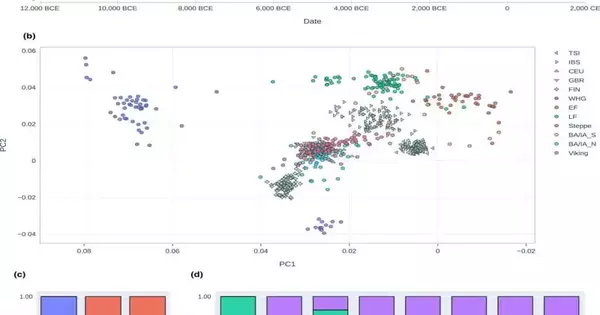Lifestyle factors like our level of fitness, whether we smoke, or whether we are overweight have a significant impact on how long we live. Additional significant outside variables include social connections, environmental circumstances, and education. The potential length of our lives is also influenced by our genes. Human longevity is defined as 95 years or more of relatively good health.
Professor Almut Nebel of the Institute of Clinical Molecular Biology (IKMB) at Kiel University (CAU) claims that variations in the APOE gene have the highest genetic contribution to longevity.
Apolipoprotein E (APOE), a crucial component of lipoproteins and the product of the APOE gene, is the building block of lipid metabolism.
“We were able to demonstrate that two significant immigration waves 7,500 and 4,800 years ago, and the subsequent mixing of population groups, are largely responsible for the current distribution of variations in Europe.”
Daniel Kolbe from Nebel’s research group.
For longevity, it is important to consider the three variants (2, 3, and 4). The very high risk of Alzheimer’s disease that APOE 4 is linked to can reduce life expectancy. On the other hand, APOE-2 increases the likelihood of living a long life, while APOE-3 is regarded as neutral. The three variants are distributed quite unevenly across Europe, with the unfavorable variant 4 being more common in the north (22 percent) than the south (6 percent).
Geographically, the frequencies of 2 and 3 differ greatly, with 2 typically being the rarest variant in a population (at most 12%) and 3 typically being the most prevalent (at least 70%). Paleogenetics was initially used to look into possible causes of this distribution by a research team under the direction of Professor Nebel. Their findings were just recently published in the journal Aging Cell.
First author Daniel Kolbe from Nebel’s research team writes, “We were able to show that the current distribution of variants in Europe arose primarily from two major immigrations, 7,500 years ago and 4,800 years ago, and the subsequent mixing of population groups. According to Kolbe, a Ph.D. candidate, “these two demographic processes can largely account for the differences between northern and southern Europe.”. D. within the GRK for Translational Evolutionary Research (TransEvo) at the CAU.
This discovery is totally original. As of now, natural selection has primarily been blamed for the different frequencies of the three gene variants. This presumption was supported by genetic information from current residents.
“We used DNA sequences from skeletons with accurate archaeological dates in our research. These give us the ability to go back in time and thereby directly investigate the potential influence of historical events,” claims Kolbe. More than 358 datasets from bone samples with a history of up to 12,000 years were used in the investigation. These were put to use in determining the frequencies of APOE variants in various European prehistoric and medieval populations.
Surprisingly, according to Kolbe, the mobile hunter-gatherers of the Stone Age had a low frequency of the 2 variant (about 5%), which is not detectable, and a high frequency of the 4 variant (about 40%), which is harmful from today’s perspective. On the other hand, the first sedentary farmers had a very low 4 frequency (roughly 4%) and a high 3 frequency (roughly 91%). These variations “likely arose as adaptations to the particular diets and lifestyles of the two groups,” according to Kolbe.
Modern research has shown that exercise can lower the risk of Alzheimer’s disease for four carriers. “It’s unlikely that we’ll ever be able to determine whether the hunter-gatherers had Alzheimer’s disease or how gene 4 may have played a role. They occasionally traveled great distances on foot, so it’s possible that they outran or escaped the bad variant, Kolbe says.
Accordingly, our study backs up the claim that leading an active lifestyle is beneficial, especially for the approximately 15% of Germans who have the 4 variant. The first farmers, however, appear to have had an advantage with numbers 2 and 3. Farmers frequently consumed high-starch diets, which may have benefited from APOE 2’s improved ability to metabolize starch. With regard to storing calories as fat as a reserve for difficult times, APOE 3 is likely to have favored this strategy.
These particular adaptations are most likely unrelated to longevity, which may be a more recent phenomenon.
This study supports the significance of evolutionary biology research methodologies for many contemporary challenges. “Our results demonstrate how an unfavorable genetic predisposition can be overcome by an adapted lifestyle, which in this case is particularly relevant for the aging population of today,” says last author Nebel, who has long studied the molecular basis of longevity.
More information: Daniel Kolbe et al, Current allele distribution of the human longevity gene APOE in Europe can mainly be explained by ancient admixture, Aging Cell (2023). DOI: 10.1111/acel.13819





